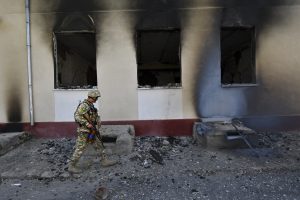In a damning report released on May 2, Human Rights Watch finds that forces from both Kyrgyzstan and Tajikistan committed apparent war crimes during their brief but violent border conflict in September 2022.
The report, titled “‘When We Moved, They Shot’: Laws of War Violations in the September 2022 Kyrgyzstan-Tajikistan Border Conflict,” offers a detailed analysis of the four-day conflict that erupted in mid-September last year, in which border forces from Kyrgyzstan and Tajikistan, along with civilians, engaged in fighting along the two countries’ undemarcated border. Among the actions detailed in the report:
Kyrgyz forces shot at ambulances and private cars carrying families trying to flee and dropped a laser-guided bomb on a town square, killing at least 10 civilians. Tajik forces shot at cars carrying civilians and unlawfully killed at least eight civilians in different circumstances, and large-scale looting and burning of private property took place in Kyrgyz villages while they were under the control of Tajik forces.
“Several of these attacks by both parties likely amount to war crimes,” the report notes.
“Civilians living in the disputed border areas of Kyrgyzstan and Tajikistan paid a heavy price for the callous conduct of both Kyrgyz and Tajik forces during the fighting last September,” said Jean-Baptiste Gallopin, senior crisis and conflict researcher at Human Rights Watch. He stressed to The Diplomat that Human Rights Watch does not take a position “on who started the conflict or who is responsible for the escalation.” Instead, the report, “analyzes the conflict under the lens of international humanitarian law, which regulates the conduct of military operations around the world, and applies to all parties to a conflict.”
“We think that it’s very important to show that both governments committed serious violations of the laws of war, including apparent war crimes,” he told The Diplomat.
Drawing on 86 interviews, on-site investigations, reviews of medical records, satellite imagery, and other documents, as well as “verification of 12 videos showing attacks and their aftermath; and 3D modeling to analyze the impact of the laser-guided bomb attack and attacks on medical vehicles,” the report strives to detail precisely what happened to yield the images we saw in the conflict’s aftermath of burned ambulances and bullet-ridden walls.
“The four days of fighting amounted to an international armed conflict that was governed by international humanitarian law,” Human Rights Watch argues. “This obliges all parties to distinguish between civilians and combatants at all times.”
That seems to be precisely what neither side did particularly well.
According to Human Rights Watch, most of the violations occurred on September 16, the third day of the conflict. These violations included the use of a Bayraktar TB-2 drone by Kyrgyz forces to strike the central square in Ovchi Kal’acha; attacks on cars carrying Kyrgyz civilians by Tajik forces; the targeting of two Tajik ambulances by shots fired from the direction of a Kyrgyz village and nearby Kyrgyz border guard base; and at least two extrajudicial executions of Kyrgyz civilians in a village briefly occupied by Tajik forces.
In the wake of the conflict, discussion about what had happened was deeply mired in nationalistic rhetoric on both sides of the border. Kyrgyzstan’s more vibrant media landscape was able to share stories from the Kyrgyz side of the border more quickly and in more detail than on the Tajik side; but both government’s responded reactively to any accusation that their forces may have committed atrocities. What the Human Rights Watch report does is eschew the blame game and focus on highlighting the horrific lived experiences of civilians caught in the middle of this conflict.
Human Rights Watch urges both the Kyrgyz and Tajik governments to mount independent investigations around the serious allegations of possible war crimes committed by their forces. They also recommend that the two sides ensure that any border demarcation agreement, or interim arrangements, “respect the right[s] of the local populations.” Human Rights Watch asks Kyrgyzstan to accede to the Rome Statue and join the International Criminal Court and presses Tajikistan to “[i]nvestigate the looting and destruction of civilian infrastructure in Kyrgyz villages by civilians apparently from Tajikistan, under the watch of Tajik forces.”
Gallopin told The Diplomat that while border delineation talks have resumed between Kyrgyzstan and Tajikistan, “militarization of the border continues and there are serious concerns that a new round of fighting could break out at any moment, potentially at a larger scale.”
Human Rights Watch said in the report that they were able to document the deaths of at least 37 civilians, including five children, and injuries to 36 more civilians — noting that media reports and official victims lists suggest there may have been as many as 51 killed and 121 injured in the conflict.































